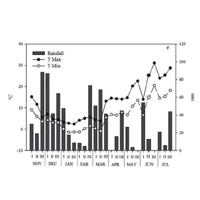Organic versus mineral fertilization: Assessing of yield and quality of durum wheat in marginal lands

Accepted: 2 June 2021
PDF: 475
All claims expressed in this article are solely those of the authors and do not necessarily represent those of their affiliated organizations, or those of the publisher, the editors and the reviewers. Any product that may be evaluated in this article or claim that may be made by its manufacturer is not guaranteed or endorsed by the publisher.
Durum wheat is often cultivated in marginal areas with great management difficulties. Organic fertilization is a sustainable agricultural practice that allows preserving the environment, but its limit can be the reduction of yield and quality of crops, also in cereals. The aim of research was to evaluate the effects of the organic fertilization on yield and quality of Simeto, a variety of durum wheat, cultivated for two years in three different sites of the internal hill of Campania Region (San Giorgio la Molara, SGM; Ariano Irpino, AI; Sant’Angelo dei Lombardi, SAL). SGM was a sandy-clay-loam soil, with high fertility, while AI and SAL were clay soil. The organic fertilization (ORG), based on roasted leather, was compared to mineral fertilization (MIN) and the not fertilized treatment (N0). In SGM, crop growth rate (CGR) and leaf area index (LAI) were significantly higher than AI and SAL until the flowering (about 2- and 4-fold more, respectively). MIN and ORG significantly boosted CGR compared to N0, while for LAI, ORG was never different from N0. The two-years value of yield was 3.0 t ha–1; in SGM, it reached 4.2 t ha–1, and it was 54.6% more than the mean value of AI and SAL, while N0 was not different from MIN of AI and SAL. ORG yield was lower and not different from NO in AI, where the lowest values of 1000 kernels weight, and hectolitre weight were also recorded. MIN and ORG increased the number of spikes per square meter: 27.0%, and 12.8% over N0, respectively, but ORG showed an 11.2% decrease compared to MIN. The 1000 kernels weight reached the highest values in SAL, without differences between N0, MIN, and ORG. The values of protein and gluten percentage were highest in AI and SGM (about 13.5%, and 11.7%, respectively), but without differences between ORG and MIN in the 3 sites for protein percentage. The worst value of the vitreousness was recorded in SAL (52.3%), six-fold more than that of AI (8.2%), probably due to the high rainfall. NUE reached the highest value in SGM in the first year, when it was significantly different from AI and SAL (0.036 vs 0.030 t kg–1). Overall, the effect of nitrogen fertilization type results sitespecific; indeed, organic fertilization had the same performance of mineral in the site with better soil (low clay content, high nitrogen, and organic matter content) and climate conditions.
Highlights
- Organic fertilization based on roasted leather was compared to mineral fertilization in three marginal environments for two years.
- Effect of organic fertilization on wheat yield, grain quality and nitrogen use efficiency was site-specific.
- Yield of plants organically fertilized was lower than mineral fertilization in the two environments less fertile and with a high clay content.
- Nitrogen use efficiency of organic fertilization was lower than mineral in the two environments less fertile and with high content of clay.
- Grain protein and gluten percentage were lower in the site with higher rainfall.
How to Cite

This work is licensed under a Creative Commons Attribution-NonCommercial 4.0 International License.
PAGEPress has chosen to apply the Creative Commons Attribution NonCommercial 4.0 International License (CC BY-NC 4.0) to all manuscripts to be published.

 https://doi.org/10.4081/ija.2021.1855
https://doi.org/10.4081/ija.2021.1855



